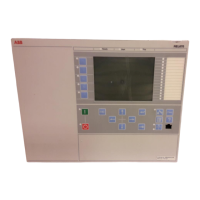1. Check the blocking of the echo with the injection of a CRL signal >40ms
after a reverse fault is applied.
2. Measure the duration of the echoed CS signal by applying a CRL receive
signal.
3. Check the trip functions and the voltage level for trip by reducing a phase
voltage and applying a CRL receive signal.
Testing conditions
GUID-301AA7D5-1DC5-47A7-A910-43E3514AE0B0 v2
Only one type of fault is sufficient, with the current reversal and weak-end infeed
logic for distance protection function ZCRWPSCH. Apply two faults (one in each
phase). For phase L1-N fault, set these parameters:
Table 25: Phase L1-N parameter values
Phase I (Amps) Phase-angle (Deg) V (Volts) Phase-angle (Deg)
L1 0 0 Set less than
UPN<
0
L2 0 180 63 180
For L2-N fault, change all settings cyclically.
The setting parameter WEI is set to Echo & Trip.
1. Apply input signals according Table 25.
2. Activate the receive (CR) signal.
3. After the IED has operated, turn off the input signals.
4. Check that trip and send signal are obtained.
The ECHO output gives only a 200 ms pulse.
10.10.2.3 Completing the test
M14947-105 v5
continue to test another function or end the test by changing the TESTMODE
setting to Off. Restore connections and settings to their original values, if they were
changed for testing purposes.
10.10.3 Scheme communication logic for residual overcurrent
protection ECPSCH
M13926-2 v6
Prepare the IED for verification of settings outlined in Section
"Preparing the IED
to verify settings".
Before testing the communication logic for residual overcurrent protection function
ECPSCH, the four step residual overcurrent protection function EF4PTOC has to
1MRK 506 377-UEN C Section 10
Testing functionality by secondary injection
Railway application RER670 2.2 IEC 157
Commissioning manual

